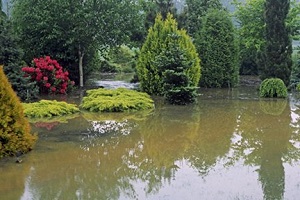A new column to help Ealing's gardens bloom
|
We gardeners are just never satisfied, are we?
Plants love water. But very few plants actually like to have permanently wet feet. So all this rain and even flooding for some is not, as you might imagine, great news for plants or gardens. They will last for around three weeks in standing water before they permanently give up the ghost.

A submerged garden – photo credit Adrian Bloom
If you are unlucky enough to be somewhere flooded, then saving your plants is unlikely to be top of your agenda. However, for the luckier ones in the West London area who just have extremely soggy gardens, here are a few tips to keep them in reasonable shape:
1. Learn to fly! Tromping around on the soil when it’s wet does it no favours – we use thin plywood boards to walk on, which spreads the weight and minimizes compression of the soil. This goes for the lawn as well as the borders. If you don’t happen to have any handy boards around, try to find anything that can spread the load – old tea trays? Place mats? Snow shoes? Ok sounds a little crazy. But soil structure, even though you can’t see it, has the greatest impact on the health of your plants, so it’s really worth giving it the best chance.
2. Consider temporary holiday homes for some plants that particularly hate wet feet, such as lavenders (think Mediterranean holidays). If you can’t pot them up, pop them into a large dustbin bag, make some holes in it, leave the top of the plants above the edge of the bag and make sure that the roots don’t dry out. Ironic I know. When the ground has drained again, you can replant them.
3. Adding grit and sand to the soil can help with drainage. I hate to say it, but prevention here is better than cure. Organic matter such as good garden compost or bought manure compost is a fantastic long term soil improver, but if the soil is really wet won’t help as much as chunky material, like grit. Bags of grit are heavy and depressing things to heave around, so only use in the worst affected boggy bits of the garden or around plants that you particularly want to flourish. If the ground is really wet then wait till the water levels drop before trying to improve the soil. Otherwise you’ll end up with a muddy cake mix and a headache.
4. Get rid of dead foliage in the garden if you haven’t already – it’s great to keep it while it’s still got some structure, and who doesn’t love those photos of frosty leaves and twinkling grasses in all the glossy winter issues of gardening magazines. But there’s nothing sadder than soggy brown stems and foliage, so time to chop it down and add to the compost heap. Deciduous grasses need chopping down now anyway, so double whammy, as they say.
5. Lawns – wait till the ground is not so wet, then lay boards on the lawn if possible and walk along spiking the ground with a garden fork, to allow some air to penetrate the top layer of soil. Quite satisfying and a good upper arm workout. Sprinkle lawn sand into the holes, which helps to keep the soil aerated.
6. Pots – check that your pots are draining well, which they should do if there are crocks of some kind in the bottom of them under the compost. If not, you’ll need to take the plants out, check their roots not black or sour smelling, remove any that are, and repot after adding a layer of broken terracotta pots or even polystyrene to the bottom of the containers. Putting them on pot feet is often recommended, though they can wobble off them I find. A matter of personal choice.
7. Weeding. Provided you can fly (or human equivalent - see 1 above) to get to the borders, it’s a perfect time to pull out those pesky weeds that have taken hold during our milder than average winter, as all this rain means the roots come out properly, rather than snapping off to cause future problems. Some find this a little boring, but it can be wonderfully therapeutic, a wee bit of virtuous exercise, a dose of Vitamin D and fresh air at the same time. Enjoyable even.
Caro is happy to answer any of your horticultural or design queries, just send them in to editor@ealingtoday.co.uk and she’ll do her best to give you the fruits and flowers of her garden wisdom.
19th February 2014
